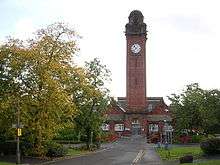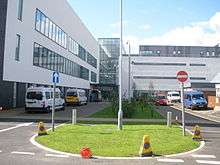Stobhill Hospital
| Stobhill Hospital | |
|---|---|
| NHS Greater Glasgow and Clyde | |
 The B-listed clock tower of Stobhill Hospital | |
| Geography | |
| Location | Balornock Road, Glasgow, Scotland, United Kingdom |
| Organisation | |
| Care system | Public NHS |
| Hospital type |
Teaching Ambulatory care Mental health |
| Affiliated university | University of Glasgow |
| Services | |
| Emergency department | In-hours (09:00–21:00) Minor injuries unit |
| Beds | 197 (12 Short-Stay Surgical, 185 Mental Health) |
| History | |
| Founded | 1904 |
| Links | |
| Website |
www |
| Lists | Hospitals in Scotland |
Stobhill Hospital is an Ambulatory Care and Diagnostic Hospital, located in the district of Springburn in the north of Glasgow, Scotland. It serves the population of North Glasgow and part of East Dunbartonshire.
History
Stobhill was originally a Poor Law hospital, commissioned by the Glasgow Parish Council, to an 1899–1900, John James Burnet-judged competition winning design by Glasgow architects, Thomson & Sandilands. The foundation stone was laid in September 1901 by Lord Balfour of Burleigh, the then Secretary of State for Scotland, and Stobhill Hospital was formally opened on 15 September 1904; the same day as the Western District Hospital at Oakbank in Maryhill and the Eastern District Hospital at Duke Street. The original buildings are now protected as category B listed buildings.[1][2]
It was built with 1,867 beds organised in several two-storey red brick Nightingale ward blocks on a sprawling, 47-acre (19-hectare) campus on the edge of Springburn Park. The Hamiltonhill Branch of the Lanarkshire and Dunbartonshire Railway, which ran past the northern boundary of the hospital grounds, facilitated the transport of coal and supplies to the hospital. The cost of the building was £250,000. It featured a large clocktower at the centre of the site, which has become a dominant landmark in the north of the city. The motto of the new hospital was Health is Wealth.
In September 1914, at the beginning of the First World War, the hospital was requisitioned by Royal Army Medical Corps staff of the Territorial Force and the complex split and redesignated as the 3rd and 4th Scottish General Hospitals. Wounded servicemen arrived by specially converted Hospital trains terminating at a temporary railway platform built within the hospital grounds. A staff of 240 TF nurses as well as volunteers from the St. Andrew's Ambulance Association cared for over 1,000 patients at a time, suffering from battlefield wounds to venereal disease, until the return of the hospital to civilian use in the spring of 1920.
In 1928 a new radiology department was opened and Stobhill became a general hospital in 1929. In 1930 Stobhill came under the control of the Glasgow Corporation and changed from being a Poor Law Hospital to become a Municipal Hospital. In 1931 a new maternity unit opened. In 1935, on the death of Sir Hugh Reid of the North British Locomotive Company in Springburn, he bequeathed the family's mansion at Balgrayhill, Belmont House, to the hospital in memory of his wife, and it was converted to become the Marion Reid Home for the care of babies and very young children in 1936. Stobhill became a teaching hospital in 1937 with the arrival of Noah Morris, Professor of Materia Medica at the University of Glasgow Medical School.
National Health Service
In 1948 it was transferred to the National Health Service, under the Board of Management for Glasgow Northern Hospitals, and designated one of the five major central hospitals of the new Western Regional Hospital Board.
Extensions followed, including a geriatric unit, which opened in 1953, a pharmacy in 1961, a premature baby ward in 1962, the Edward Unit for Mothers and Babies in 1963, a staff library in 1964, the Clinical Teaching Centre and the Group Training School in 1967 and a modern Pathology Department in 1968. A new operating theatre and postgraduate medical teaching complex opened in 1970, although the bed complement had dropped below 1,000 by 1965.
With the reorganisation of the National Health Service in 1974, Stobhill became the responsibility of the Northern District of the Greater Glasgow Health Board. A 52-bed Marie Curie Cancer Care hospice was opened adjacent to the hospital in 1976. The maternity unit was closed in 1992,[3] leaving Stobhill as a general and geriatric medicine hospital. Responsibility for the management of Stobhill passed to the Stobhill NHS Trust in 1993. In 1999 this Trust was replaced by the larger North Glasgow University Hospitals NHS Trust which also included the Glasgow Royal Infirmary, Western Infirmary, Gartnavel General Hospital and the Dental Hospital. NHS Trusts have since been abolished in Scotland and the hospital is now in the charge of NHS Greater Glasgow and Clyde.
New Stobhill Hospital

Ambulatory Care Hospital
The Greater Glasgow's Acute Services Review, published by NHS Greater Glasgow in 2002, recommended replacing the existing Stobhill Hospital building and its 440-bed general medical and surgical inpatient facilities with a £100M outpatient Ambulatory Care and Diagnostic Hospital. Controversy over this decision resulted in Jean Turner's election as an Independent Member of the Scottish Parliament for Strathkelvin and Bearsden over this single issue in 2003.
Despite this, the new hospital, specialising in areas such as Day Surgery, opened in June 2009. The new hospital building was designed by Reiach and Hall and was voted the world's best hospital of its size in the 2010 Design and Health International Academy Awards in addition to being recognised by the Royal Institute of British Architects.[4][5]
This reorganisation resulted in the nearest Accident and Emergency and general inpatient facilities being relocated to the Glasgow Royal Infirmary in the city centre, as inpatient and A&E services were eventually phased out in March 2011.
The new Stobhill Hospital provides general outpatient treatment and diagnostic services such as: physiotherapy, podiatry, occupational therapy, dietetics, speech and language therapy, renal dialysis, heart and lung investigations, cardiac rehabilitation, elderly day care, diabetic care, a chronic pain service, x-rays, CT scans, MRI scans, ophthalmology, dentistry, ENT and audiology, gynaecology investigations, haematology and dermatology.
It has 12 short stay surgical beds, which will enable clinicians to extend the range of outpatient day surgical procedures offered within the new hospital, as well as an in-hours (09:00–21:00) Minor injuries unit and out-of-hours GP service. It is one of Scotland's largest hospital facilities, covering four floors and a floorspace of 30,000 square metres.
Mental health facilities
- MacKinnon House is a purpose built adult inpatient mental health unit, opened at Stobhill Hospital in April 2000 following the closure of Woodilee Hospital. The unit comprises three twenty-bed wards (Broadford, Armadale and Struan Wards) and a 12-bed Intensive Psychiatric Care Unit (Portree Ward) and an ECT suite.
- Eriskay House, a 15-bed inpatient ward opened in October 2004 as an addition to the MacKinnon House adult inpatient mental health unit. This purpose-built ward, which compliments inpatient services at Parkhead Hospital and replaces those at the former Ruchill hospital, providing services for patients with substance addiction problems.
- Skye House, opened in February 2009, replaces an existing interim facility for young people at Gartnavel Royal Hospital. Housing 24 beds, the £7M purpose-built unit has separate residential, educational and therapeutic facilities and has been designed to meet the needs of young people who need inpatient mental health care.
- Rowanbank Clinic, opened in July 2007, is a new 74-bed mental health secure care centre. This £18M facility will provide Forensic psychiatry services for people with acute mental health problems who may pose a risk to others or have the potential to commit a criminal offence due to their mental illness.
Marie Curie Hospice
Marie Curie Cancer Care has a hospice at Stobhill. The charity built a new hospice which was opened in January 2010. The 30-room hospice replaces the charity's old building in nearby Belmont Road which cared for more than 1,200 patients and their families each year. The old hospice has now been demolished.
Trivia
Richard Wilson, OBE worked as a lab technician at the hospital for several years before becoming an actor.
Alasdair Gray's 1981 novel Lanark features a complex, rambling building called The Institute which the author states was physically inspired by Stobhill and BBC Television Centre in London.
According to his autobiography American On Purpose, Scottish-American TV personality Craig Ferguson was born at the hospital at 6:10 a.m., 17 May 1962.
Bert Jansch, founder member of The Pentangle was born at Stobhill hospital.
References
- ↑ "Stobhill Hospital". Historic Scotland. Retrieved 15 May 2012.
- ↑ "Stobhill Hospital, Water Tower Block". Historic Scotland. Retrieved 15 May 2012.
- ↑ "Down Memory Lane – February 9, 2012 - Local History". Kirkintilloch Herald. 2012-02-07. Retrieved 2012-02-14.
- ↑ "NHSGGC / Media Centre / News Story". nhsggc.org.uk. 2010-05-21. Retrieved 2012-02-14.
- ↑ Vivienne Nicoll (2010-06-09). "£100m Stobhill named world's best hospital - Evening Times | News | Editor's Picks". Evening Times. Retrieved 2012-02-14.
External links
Coordinates: 55°53′38″N 4°13′21″W / 55.8939°N 4.2225°W